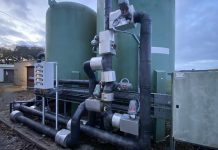Northumbrian Water’s NWG Innovation Festival brought 1,000 people, including delegates from around the world, to the North East to explore new ideas for the industry.
Some of the world’s biggest names in business took part in the event over five days at Newcastle Racecourse, including IBM, Microsoft, Ordnance Survey, BT, CGI Group and Reece Innovation.
Themes investigated included flooding, leakage, infrastructure, green cities and mobile working, and the hundreds of ideas submitted were streamlined to produce 18 projects that can be developed.
Carl Pheasey, Director of Strategy and Policy at water industry regulator Ofwat, said: “I think the idea is fantastic and it’s very timely, because the launch of PR19 – where Ofwat has outlined the areas we believe the water industry should put its focus on – puts a lot of emphasis on innovation and so this is the sort of event that I think we probably want to see more of in the future.
“There is definitely something about collaboration that is really important to doing innovation well. My limited experience of these sorts of processes in other sectors is that the really good innovative ideas come out when you get people from very different backgrounds and frames of reference coming together and trying to take a fresh look at how to solve long-standing problems.”
Heidi Mottram, Chief Executive of Northumbrian Water, said: “The amount of time you spend tackling problems over the course of the year adds up to a lot of working hours. The NWG Innovation Festival has enabled us to achieve that in five days.
“There is a lot of hard work still to be done in delivering these ideas but we are convinced that the spirit of collaboration and innovation will continue long after the festival has closed, because these are important issues that deserve the continued focus of all involved.”
‘Preparing for the Future’: How do we upgrade our infrastructure for the 21st Century?
Led by headline sponsor Reece Innovation
• Greater sharing of information between businesses, to ensure that services can be delivered in a way that better suits customers, with a particular focus upon those members of the public who are vulnerable and need additional support.
• Sensor mapping technology that improves knowledge of the various service infrastructure, such as gas, electricity and water, that lies beneath the ground.
• The introduction of a system where communities can tell companies, such as those that deliver services, what is important to them.
• The introduction of shared infrastructure corridors, allowing different businesses to use the same pipes for their services, improving information sharing and reducing the impact upon the public of maintenance.
• The use of technology such as fibre optics to improve the data available on utilities networks, particularly focusing on pipes and cables beneath the ground, to allow companies to identify problems more quickly.
‘Keep It Flowing’: What do we know about leakage from water pipes and how can we fix it?
Led by NWG.
• A tool that allows water companies to focus their efforts on areas where the biggest impact on leakage reduction can be made.
• A system that will allow water companies to more closely monitor their network of pipes, highlighting deterioration and areas of risk before leaks happen.
• The use of mobile apps that allow members of the public to report leaks with greater accuracy, using geospatial technology.
• More collaboration with experts outside of the sector, using the power of data to deliver a better customer service.
‘Rain, Hail or Shine’: How can we reduce flooding?
Led by headline sponsor IBM
• Members of the public who would work closely with relevant agencies and help to keep communities informed, to help reduce flood risk and enable people to be better supported when they are affected.
• The creation of an agency that links directly with customers to give and receive bespoke information on flooding, helping to reduce flood risk.
• A collaborative approach to reducing the surface water that runs from the landscape into water courses.
• A system that utilises artificial intelligence technology to deliver bespoke flood information to users, so they are better informed about how to respond when problems occur.
‘Tomorrow’s World’: What will living and working look like in 2030?
Led by headline sponsor CGI
• A ‘life assistant’ that filters through the increasing volumes of information, from such areas as e-mail and social media, to prioritise what is delivered to users and when.
• A personalised artificial intelligence device to learn about the environments and schedules that best suit the wearer, helping them to adapt their working practices accordingly.
‘How Green is Your City?’: What can businesses do to improve the environment in the North East?
Led by headline sponsor Ordnance Survey
• Installing special ‘moss trees’, which absorb pollution, into towns and cities. The trees would also help to reduce surface water that might enter sewers and contribute towards flooding. This idea will be entered into Ordnance Survey’s Geovation Challenge in October, alongside hundreds of other ideas from around the world, where it will compete for funding that will help it to realise its potential.
• A text message and app system that will alert people to opportunities to car share, work from home or an alternative location, and advise on time, money and carbon savings.
‘21st Century Reach’: How can we optimise a mobile workforce for a complex network business?
Led by headline sponsor BT
• Creating a single, integrated system, that brings together all of the information necessary for a particular job, from details of the work, the tools needed, recordings of the initial call from the customer, previous jobs at that location, and even training videos.







